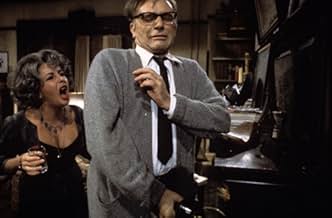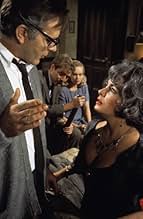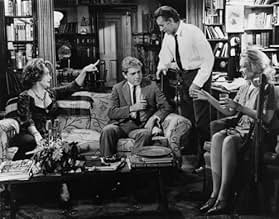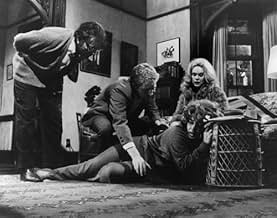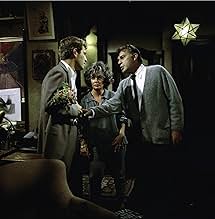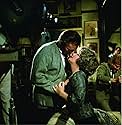Ein verbittertes, in die Jahre gekommenes Ehepaar benutzt mit Hilfe von Alkohol ein anderes Paar dazu, sich gegenseitig zu quälen und emotional zu verletzen.Ein verbittertes, in die Jahre gekommenes Ehepaar benutzt mit Hilfe von Alkohol ein anderes Paar dazu, sich gegenseitig zu quälen und emotional zu verletzen.Ein verbittertes, in die Jahre gekommenes Ehepaar benutzt mit Hilfe von Alkohol ein anderes Paar dazu, sich gegenseitig zu quälen und emotional zu verletzen.
- Regie
- Drehbuch
- Hauptbesetzung
- 5 Oscars gewonnen
- 22 Gewinne & 26 Nominierungen insgesamt
Empfohlene Bewertungen
Simply put, this is one of my favourite films of all time. Great acting, great writing and great camerawork make this close to cinematic perfection. Liz Taylor and Richard Burton give the performances of their lives. Sandy Dennis also shines in an early-ish role. It's a dramatic film, but the wicked humour that permeates the film is absolutely devastating, and I mean that in the best possible way. Many moments in the film I find myself laughing only to think, "Should I be laughing at this." Certainly the film is loaded with uncomfortable moments, enhanced by the camerawork replete with uneasy close-ups. Most of all, this film shows how a lot can be accomplished with just a little: a cast of four and minimal scenery changes. "Who's Afraid Of Virginia Woolf" has become an absolute icon of American cinema. If you haven't seen it, what are you waiting for?
One only has sympathy for these ultimately dysfunctional characters as they unfold their little "fun and games," like "Down the Host," "Hump the Hostess," and "Get the Guests." If only George and Martha had retired a wee bit earlier none of this would've happened.
Then, too, why didn't Nick and Honey simply leave, rather than stick around for the "full treatment"? Can it be that "like attracts like," so much so that they couldn't leave?
The final denouement suggests that a new day may be in the offing for poor Martha and George, after the latter has "killed off the 'little bugger.' " Although Martha's admittedly still fearful, she clings firmly to George's hand. Perhaps there's some hope, anyway, for this emotionally spent couple.
Edward Albee, taking no small degree of awareness from Tennessee Williams and Harold Pinter, crafted a play that certainly communicated to a goodly number of people.
Personally recalling sitting in its Broadway run, watching Uta Hagen and cast go through their paces, I remember being as impressed with the riotous audience laughter as with the play itself. The raw lines coming from up-to-then very respectable status characters, namely college prof and wife, seemed to provide some kind of early 60s liberation from the staid and repressive 50s.
By the time the film was released in '66, the public was ready for its no-holds-barred dialogue. It ushered in an new era of social upheaval, of which we're still feeling the effects today.
The "boozy battle" between the hosts, hosts and guests, and guests and guests, paralleled the cultural "steam" being released during that politically "hot" period. The American home drastically changed as a nation experienced more domestic squabbles, separations, divorces, custody battles, and family breakdowns--the last including a noted demise of the traditional "family meal."
In Albee's "long night's journey into morning," the audience must endure two hours of fighting, bickering, insulting, and lamenting before any ray of hope is introduced (during its last five minutes). A long time to wait, but there it is: a glimmer that there may be something better ahead. But we're not sure; after all, "Is this fact or fiction, Martha?"
In an extensive GM Quarterly interview, Director Mike Nichols revealed that this was a very troubled production that almost didn't get finished--with a leading cast boozing and pill-dosing even during lunch breaks--stretching the very limits of professionalism.
Yet in the end, Nichols, Cinematographer Haskell Wexler, and Composer Alex North all got what they wanted. A question is, "was it all worth the effort?" That's something only the individual viewer can answer: is this a case of "nothing from nothing leaves nothing?" or "a cathartic and emotionally moving experience?"
Then, too, why didn't Nick and Honey simply leave, rather than stick around for the "full treatment"? Can it be that "like attracts like," so much so that they couldn't leave?
The final denouement suggests that a new day may be in the offing for poor Martha and George, after the latter has "killed off the 'little bugger.' " Although Martha's admittedly still fearful, she clings firmly to George's hand. Perhaps there's some hope, anyway, for this emotionally spent couple.
Edward Albee, taking no small degree of awareness from Tennessee Williams and Harold Pinter, crafted a play that certainly communicated to a goodly number of people.
Personally recalling sitting in its Broadway run, watching Uta Hagen and cast go through their paces, I remember being as impressed with the riotous audience laughter as with the play itself. The raw lines coming from up-to-then very respectable status characters, namely college prof and wife, seemed to provide some kind of early 60s liberation from the staid and repressive 50s.
By the time the film was released in '66, the public was ready for its no-holds-barred dialogue. It ushered in an new era of social upheaval, of which we're still feeling the effects today.
The "boozy battle" between the hosts, hosts and guests, and guests and guests, paralleled the cultural "steam" being released during that politically "hot" period. The American home drastically changed as a nation experienced more domestic squabbles, separations, divorces, custody battles, and family breakdowns--the last including a noted demise of the traditional "family meal."
In Albee's "long night's journey into morning," the audience must endure two hours of fighting, bickering, insulting, and lamenting before any ray of hope is introduced (during its last five minutes). A long time to wait, but there it is: a glimmer that there may be something better ahead. But we're not sure; after all, "Is this fact or fiction, Martha?"
In an extensive GM Quarterly interview, Director Mike Nichols revealed that this was a very troubled production that almost didn't get finished--with a leading cast boozing and pill-dosing even during lunch breaks--stretching the very limits of professionalism.
Yet in the end, Nichols, Cinematographer Haskell Wexler, and Composer Alex North all got what they wanted. A question is, "was it all worth the effort?" That's something only the individual viewer can answer: is this a case of "nothing from nothing leaves nothing?" or "a cathartic and emotionally moving experience?"
Who's afraid of Virgina Wolf? contains what I would call the most outstanding old school actor/audience experience I'ver ever seen. This movie is 131 minutes long and only contains 5 actors, on of which hardly gets any screen time and the two leading characters played by the famous couple Richard Burton and Elizabeth Taylor are on screen almost the whole time. Also this movie only contains a couple of locations so the whole project depends almost entirely on these two actors superb performance. The two of them fight almost the entire movie and it never gets boring for a second. Well, I gave this movie ten stars..... definitely a classic must see if you're interested in acting.
10OttoVonB
Ailing couple George (Burton) and Martha (Taylor) invite a young couple over for a late-night drink - much to quiet and repressed George's annoyance - and what starts off as a twisted game by sultry Martha to annoy her husband and get her way with young stud Nick (George Segal) ends up in a horrific duel of wits.
Adapted from the play and boasting very few locations, "Virginia Woolf" is notable for many unsuspected reasons. Designed for the stage, the film makes the story uniquely cinematic and tense, amped up by stunning photography (in Black and White, a daring choice in 1966). The younger leads are superb, but Burton and Taylor still manage to walk away with film, giving stunning renditions of the world's most demented couple. They make the surreal dialogue hurt and touch in ways never thought possible.
Though there are countless reasons to recommend this jewel of a film, there are also reasons why one would wish to avoid it. This is the kind of film that makes you feel like having a showing (or a very concentrated drink) to wash away the grit and human evil and pain absorbed. You'll feel dirty, but in a way you'll also feel enlightened: that a small character film can carry more punch than any explosion-packed blockbuster out there is a thing of beauty indeed!
Adapted from the play and boasting very few locations, "Virginia Woolf" is notable for many unsuspected reasons. Designed for the stage, the film makes the story uniquely cinematic and tense, amped up by stunning photography (in Black and White, a daring choice in 1966). The younger leads are superb, but Burton and Taylor still manage to walk away with film, giving stunning renditions of the world's most demented couple. They make the surreal dialogue hurt and touch in ways never thought possible.
Though there are countless reasons to recommend this jewel of a film, there are also reasons why one would wish to avoid it. This is the kind of film that makes you feel like having a showing (or a very concentrated drink) to wash away the grit and human evil and pain absorbed. You'll feel dirty, but in a way you'll also feel enlightened: that a small character film can carry more punch than any explosion-packed blockbuster out there is a thing of beauty indeed!
WHOS's AFRAID OF VIRGINIA WOOLF? is a drama film with the elements of black comedy, that on the violent and honest way indicates marital frustration and psyche, through the alcoholism, aging, cynicism and sterility. A dangerous double game becomes more intense and urgency with environmental changes. Simply, we are going through an intimate experience, which is seasoned with an excellent acting. The problem occurs in the moment, when we realize, how much is this experience, as a matter of fact, sincere and painful.
George, an associate history professor at a small New England college, and Martha, the daughter of the university president, live in an unstable and violent marriage. After they return home drunk from a party, Martha reveals she has invited a young married couple, whom she'd met at the party, for a drink. Their guests are Nick, a biology professor, and his wife, Honey. The hosts are engaged in a cruel verbal duel. The younger couple is first embarrassed and later enmeshed. After an evening of a sadistic, perversely hilarious and dangerous clashes", a painful truth comes to the light.
Mr. Nichols keeping his camera close, so that, violent emotions, defeats and cramps on the faces of the actors come to the fore. The direction is excellent, because it is very difficult to draw the line between passion borders and boundaries of a nervous breakdown. The characters are lost in a futile and desperate struggle, which celebrates a kind of demonic love in an attempt to save a bad marriage.
The characterization is excellent and fully corresponds with sharp dialogues and gloomy atmosphere.
Elizabeth Taylor as Martha is definitely a major figure in this film with her acceptance of gray hair and her use of profanity. It is difficult to accept that such a beautiful face hides a violent and so crazed but again, fragile and deeply wounded character. Richard Burton as George is worthy as a her counterweight. He is not a victim, he is the husband who is tired of everything, while he tries to put all the things in the right place. The couple has offered an excellent performance.
George Segal as Nick is a young man who moves between confusion, arrogance and dominance in their relations. Sandy Dennis as Honey is his bland wife. She is not up to this unscrupulous game.
This is a brutal clash between unhappy spouses who move the boundaries of inhumanity, while they skillfully flee from the truth.
George, an associate history professor at a small New England college, and Martha, the daughter of the university president, live in an unstable and violent marriage. After they return home drunk from a party, Martha reveals she has invited a young married couple, whom she'd met at the party, for a drink. Their guests are Nick, a biology professor, and his wife, Honey. The hosts are engaged in a cruel verbal duel. The younger couple is first embarrassed and later enmeshed. After an evening of a sadistic, perversely hilarious and dangerous clashes", a painful truth comes to the light.
Mr. Nichols keeping his camera close, so that, violent emotions, defeats and cramps on the faces of the actors come to the fore. The direction is excellent, because it is very difficult to draw the line between passion borders and boundaries of a nervous breakdown. The characters are lost in a futile and desperate struggle, which celebrates a kind of demonic love in an attempt to save a bad marriage.
The characterization is excellent and fully corresponds with sharp dialogues and gloomy atmosphere.
Elizabeth Taylor as Martha is definitely a major figure in this film with her acceptance of gray hair and her use of profanity. It is difficult to accept that such a beautiful face hides a violent and so crazed but again, fragile and deeply wounded character. Richard Burton as George is worthy as a her counterweight. He is not a victim, he is the husband who is tired of everything, while he tries to put all the things in the right place. The couple has offered an excellent performance.
George Segal as Nick is a young man who moves between confusion, arrogance and dominance in their relations. Sandy Dennis as Honey is his bland wife. She is not up to this unscrupulous game.
This is a brutal clash between unhappy spouses who move the boundaries of inhumanity, while they skillfully flee from the truth.
Wusstest du schon
- WissenswertesThis became the first movie in Academy Awards history since Pioniere des wilden Westens (1931) to be nominated for every Academy Award category in which it was eligible, including Best Adapted Screenplay (Ernest Lehman), Director (Mike Nichols), all of the acting categories (Richard Burton, Dame Elizabeth Taylor, George Segal and Sandy Dennis) and Picture of the Year (Ernest Lehman).
- PatzerThe four characters stop at a bar after the first soiree at George's house. It is clearly after 2:00 a.m., since the time was stated during the first segment. No bars, however, would have been open after 1 or 2 a.m. in the New England states, where the film is set.
- VerbindungenEdited from Das Geheimnis von Malampur (1940)
- SoundtracksWho's Afraid of Virginia Woolf?
(to the tune of "Here We Go Round the Mulberry Bush")
Traditional English melody
Original lyrics ("Who's Afraid of the Big Bad Wolf?") by Frank Churchill and Ann Ronell; modified by Edward Albee
Performed by Elizabeth Taylor
Top-Auswahl
Melde dich zum Bewerten an und greife auf die Watchlist für personalisierte Empfehlungen zu.
Details
- Erscheinungsdatum
- Herkunftsland
- Sprachen
- Auch bekannt als
- ¿Quién le teme a Virginia Woolf?
- Drehorte
- Cambridge, Massachusetts, USA(location)
- Produktionsfirmen
- Weitere beteiligte Unternehmen bei IMDbPro anzeigen
Box Office
- Budget
- 7.500.000 $ (geschätzt)
- Bruttoertrag in den USA und Kanada
- 28.000.000 $
- Weltweiter Bruttoertrag
- 28.007.258 $
- Laufzeit2 Stunden 11 Minuten
- Farbe
- Sound-Mix
- Seitenverhältnis
- 1.85 : 1
Zu dieser Seite beitragen
Bearbeitung vorschlagen oder fehlenden Inhalt hinzufügen


